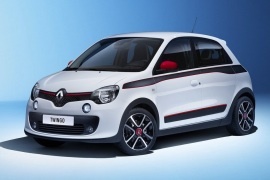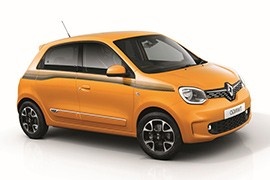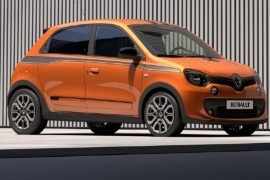
RENAULT Twingo
Generations Timeline, Specs and Pictures

Renault Twingo is a mini car unveiled by the French carmaker in 1992 at the Paris Auto Show but introduced in production in early 1993.
Since it was first presented to the general public, the Twingo received multiple facelifts in 1998, 2000 and 2004 as well as a second generation in 2007. Although it shared numerous parts with lots of other Renault models, the Twingo managed to gain the market’s attention with the help of its interior which is regarded as one of the most attractive in its class. The first models were equipped with a 1.2 8V or 16V engine which could produce 60 and 75 horsepower respectively.

After twenty two years since it cam on the market, the Renault Twingo city car is back in 2014, coming with something it never had - a rear engine.
This, along with the rear-wheel-drive transmission makes the new Twingo even more fun to drive around the city, freeing up the front of the car and enabling it to dive faster into corners.
Stylistically, the designers started from a blank paper as you can see, the new Twingo barely resembling with its previous siblings. It has it’s own personality now, mostly inspired by the Renault 5, including the rake of the rear screen and prominent shoulders. The front fascia is dominated by the large badge on a black background, big headlights as well as the LED daytime running lights.
The car is offered in a choice of four vibrant colors - light blue, white, yellow and red - which are also found scattered through the funky interior, which also boasts a collection of newer and better materials arranged into a combination of neo and retro styled shapes.

Renault first introduced Twingo in 1992 as a four-passenger city car with a turning circle of only 4.30m.
The new Twingo, launched in 2019, comes with a loading length of 2.31 meters and 3 available engines. The SCe 75 engine provides the best balance between fuel consumption and driving joy, helping to reduce gasoline consumption and cut CO2 emissions (this engine is available with a manual five-speed gearbox), whilst the TCe 95 (which can be combined with the automatic transmission called Efficient Dual Clutch), allows you to quickly escape from the city.
There are two new colors available, Mango Yellow, and Quartz White and six available shades to choose from, Starry Black, Flame Red, Lunar Grey, Crystal White, Pistachio Green, and Pale Blue.
In regards to the safety of the car, Renault Twingo protects its customers with programmed deformation zones around the survival cell, four airbags and seat belts with pre-tensioners. Electronic driving assistance includes hill start assist and lane departure warning.
Also, the new Renault Twingo comes with a system based on a 7-inch touchscreen tablet, with two multimedia systems, R & Go app and Easy Link that you can connect to Apple and Android smartphones and allow you to use Waze or Google maps for navigation.

We can probably all agree that the Twingo was not the most stylish small car out there.
Along the years, the Renault Twingo was mostly sold for its modularity. The sliding rear bench was very practical and the Twingo had built reputation on interior space.
For 2007, Renault decided to bring a sportier version of the regular Twingo, the Twingo GT.
The new model didn’t sport the already known roundness of its predecessor and used the styling from the then-new Modus and Clio.
The Twingo GT was better equipped and more solid and it was the Renault’s first attempt at building a sporty version of the regular vehicle.
With the GT version, the exterior design featured its own specific front bodywork, chrome tail pipes, 15-inch alloys, a roof spoiler and sating grey side mirrors.
While the overall look wasn’t all that attractive, the front was more appealing than the rear end.
The Twingo GT was available with a new 1.5-liter DCi unit or a 1.2-liter powerplant with 100 hp. Renault stated that the small 1.2-liter unit offered the torque of a bigger 1.6-liter one.
Inside, the materials’ quality was greatly improved and the everything looked well put together.
Even the driving position was optimised to make the driver feel safer while driving more aggressively.

Renault tweaked the Twingo to provide more fun in a small package and introduced it in a GT trim level in 2016.
Renault developed the third generation of the Twingo together with Mercedes-Benz. The German carmaker introduced it under the SMART brand, while Renault continued its supermini saga with a four-door vehicle, which was something new for it. Moreover, the return of the rear-wheel-drive system, with a rear-engine, was something that the French carmaker didn’t have in decades. But things didn’t stop there. With some help from Renault Sport, the GT version promised to be more fun to drive.
Like any other GT version from the Renault range, the Twingo received a specific package. At the front, the car featured a black, wider grille at the bottom which incorporated two fog lights. Its ground clearance was lowered when compared to its non-GT siblings. From its sides, the 17” light-alloy wheels were striking since usually, the cars from that segment wore 15 or 16 inches alloys. At the back, a roof spoiler and a twin exhaust completed the sporty package.
Inside, the Twingo GT received new bucket seats with incorporated headrests. The upholstery was designed with stripes that matched the car’s exterior color. Like its siblings, it featured a digital instrument panel with an analog speedometer around it. On the center stack, the infotainment system offered Android Auto and Apple CarPlay connectivity.
Behind the cabin, under the rear trunk, Renault installed an inline-three turbocharged engine. It provided 110 hp, which was more than enough to transform the tiny car into a mini hot-hatch.

After four years on the market, the second generation of the Twingo received a well-deserved update and regained some of its customers.
While the first generation of the Twingo was more or less an experiment for the French carmaker, the second generation was a hit among the supermini vehicles. This time it had the correct dimensions to accommodate four people inside, and not just four skinny dwarfs, and it showed something more about its customers. It was a “tres chic” car.
For the second generation, the facelift worked like a charm removing all the wrinkles that showed on the older design. Its new auxiliary lights installed inboard of the main headlamps transformed the little Twingo into an easy to recognize vehicle in its class. Like its predecessor, it was available only in a three-door version. Its door handles remained the same, half-buried behind the rear side of the doors. At the back, the taillights marked another unique design element, with an additional set of lights on the tailgate.
Inside, the car sported a fresh design with the instrument cluster placed on top of the center stack, tilted toward the driver. In front of the steering wheel, the carmaker put a storage compartment excellent for a phone or a small purse. Another significant improvement was the new phone-holder installed instead of the audio system. That transformed the owner’s phone into a navigation system or an MP3 player via a dedicated app.
Under the hood, Renault installed a choice of three gasoline and two turbo-diesel engines. A particular version, named Gordini, paid homage to the genius engineer that built race-versions for Renault in the late ’60s and early ’70s, with blue cars and two white stripes over the bodywork.

The second generation of the Renault Twingo came on the market in 2007 and it offered a good solution for the urban mobility at an affordable price on a car-market that was sinking.
While the first generation became famous after picturing two sumo fighters aboard and out through the folded rooftop, the second generation came without that option. But it came well-equipped and with a better safety package.
The look of the car was enhanced by the addition of two fog-lights mounted up on the front bumper, mixing with the main headlights which were swept-back. The short hood was continued by the greenhouse, which was short. The entire car was short and with its flat and straight tailgate looked like someone cut the end of it. But that was the idea: a short car for the city with great rearview visibility to ease-up parking.
Inside, the 2007 Twingo carried-over the idea from its predecessor, with rear sliding seats. That allowed an increase for the trunk or legroom. Due to the high greenhouse, the headroom was not an issue even for adults over 6 feet (1.82m). The center-mounted instrument cluster looked funky and visible for all the passengers on board. There was an option for a tachometer mounted on the steering column, behind the steering wheel.
For the engine compartment, Renault offered a choice of two engines: a diesel and a gasoline, each of them in two power outputs. The only tranny available was a 5-speed manual.























































